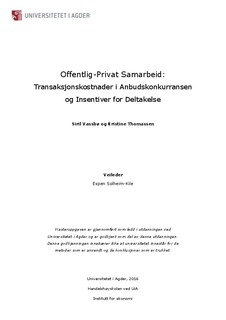| dc.description.abstract | Kristiansand municipality decided to procure Justvik school through public-private partnership
(PPP). The idea was to utilize private sector´s efficiency, management and expertise to design,
build, finance and operate a public school through a long-term contractual arrangement. The
model is debated as the desired efficiency gains are not proved to exceed the costs of the model.
Previous research indicate that there is significant use of resources associated with PPP
tendering. This paper examines the transaction costs in tendering for a PPP project. The research
provides no basis for comparison with other procurement models. Special for the PPP model is
that part of the transaction costs have shifted from public to private sector. Participation in a
tender may therefore lead to losses for the private actors. On the contrary, winning such a
competition can contribute to higher profit, improvement of the company´s position, and added
value through new partnerships. Contractors´ ability to choose the right contracts is important
for their success. The purpose of this study was to investigate the amount of transaction costs
involved in a PPP project, and why private actors wanted to participate. Agency theory and
transaction cost theory was used as a theoretical foundation in order to answer the research
question.
The research method used for this study was a case study of Justvik school. What makes this
case interesting is the access to key actors from the public and private sector. Semi-structured
in-depth interviews and focused interviews was carried out, triangulated with key documents,
providing an opportunity to conduct a deep and rigorous analysis. Twelve public and private
actors were carefully chosen in order to ensure a holistic picture with multiple perspectives.
The results showed that there were significant transaction costs involved in the tender. 70-
80ipercent of the total tender costs were transaction costs. These costs are explained by the
relatively long and extensive competition, presented in nine stages. Despite these costs, bidders
seemed to find it attractive to participate in the tendering because of the incentives present.
These constituted both pecuniary incentives like higher expected profit, but also non-pecuniary
incentives like being allowed to influence the project to a larger extent.
The work with the thesis resulted in two scientific research papers that was accepted for
presentation and inclusion in the conference proceedings at International Conference on Project
Management (ProjMAN). | nb_NO |
